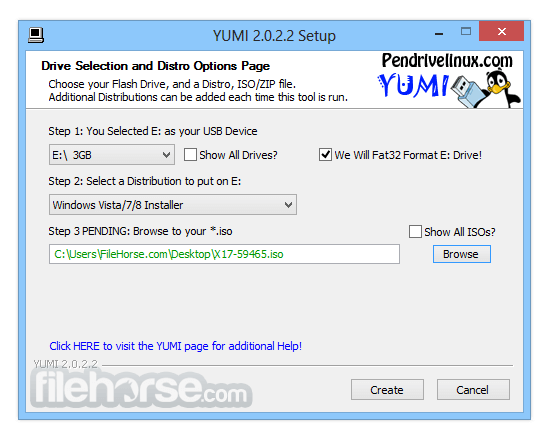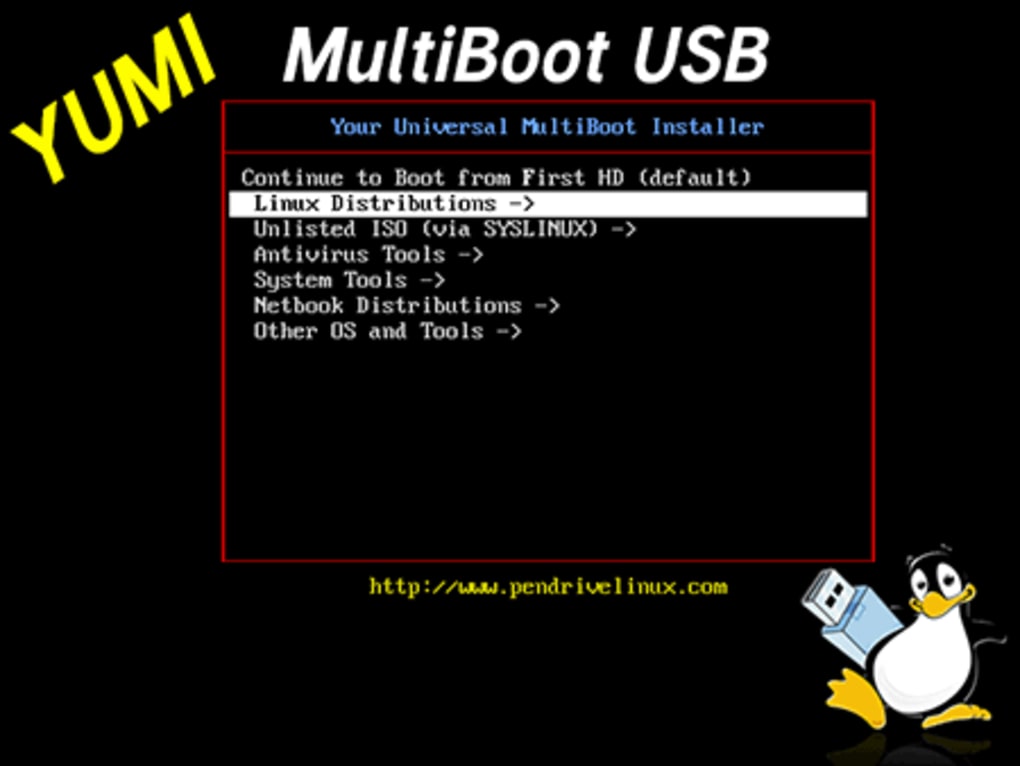YUMI: The Multiboot USB Solution To Common Digital Sins
What is YUMI? Your USB Multiboot Installer Explained
At its core, **YUMI** stands for "Your USB Multiboot Installer." It is a powerful, free, and open-source utility designed to simplify the creation of multiboot USB flash drives. Unlike traditional methods that allow only one operating system or utility per drive, YUMI enables users to consolidate multiple bootable ISO files onto a single USB stick. This means you can have various versions of Windows, multiple Linux distributions, and a suite of diagnostic and recovery tools all accessible from one portable device. The genius of YUMI lies in its ability to organize these diverse bootable images. When you boot from a YUMI-created USB, you're presented with a menu that allows you to select which operating system or tool you wish to launch. This eliminates the "sin" of having a cluttered collection of single-purpose bootable media, transforming a pile of discs or individual USBs into one highly efficient, versatile tool. It works as a versatile USB Windows media creator, a Linux installer, and much more, making it an indispensable asset for IT professionals, system administrators, and anyone who frequently deals with computer installations or troubleshooting.Why YUMI? The Redemption from Single-Purpose USB Sins
The need for a tool like YUMI arises from the inherent inefficiencies of traditional bootable media. Imagine a scenario where you need to install Windows 10 on one machine, then Ubuntu on another, and perhaps later run a memory diagnostic tool. Historically, each of these tasks would require its own dedicated DVD or USB drive. This fragmented approach not only consumes physical space but also wastes time in preparation and selection. YUMI offers a clear path to redemption from these digital "sins" of disorganization and inefficiency.Efficiency and Versatility Unleashed
One of the primary reasons to embrace YUMI is its unparalleled efficiency. A single YUMI drive can contain installation files for multiple operating systems, thus eliminating the need of having a separate disc for each. This capability is invaluable for anyone who frequently installs or re-installs operating systems. For instance, if you're currently trying to install Ubuntu alongside your Windows 10 machine, having both ISOs on a single YUMI drive simplifies the process immensely. You can easily create a YUMI multiboot USB for Windows and Linux, allowing you to boot multiple ISOs, live distributions, and tools—all from one USB stick! This versatility is a game-changer, transforming your toolkit from a scattered mess into a streamlined, powerful resource.Diagnostic and Recovery Powerhouse
Beyond just OS installations, YUMI shines as a diagnostic and recovery powerhouse. It allows you to add disk manager software, antivirus boot discs, memory testers, and other crucial utilities. For example, you can easily create an Ultimate Boot CD (UBCD) bootable USB flash drive from Windows using YUMI. UBCD is a widely used computer diagnostics tool, and having it readily available on your multiboot drive means you're always prepared for system failures or troubleshooting. This preparedness helps avert the "sins" of being caught off guard by system issues, providing a robust safety net for your digital life.Getting Started: Your First Steps with YUMI
Embarking on your YUMI journey is straightforward. The first step is to get YUMI or UUI (Universal USB Installer, another tool from PendriveLinux) from the official PendriveLinux website. Once downloaded, you'll need a USB flash drive. It's recommended to use at least an 8 GB (or larger) USB drive, especially if you plan to include multiple operating systems and diagnostic tools. The larger the drive, the more versatile your YUMI multiboot stick can become. The process typically involves: 1. Running the YUMI executable. 2. Selecting your USB drive from a dropdown menu. 3. Choosing the Linux distribution or Windows version ISO you wish to add. 4. Browsing to the ISO file on your computer. 5. Clicking "Create" to start the process. YUMI will then format the drive (if necessary, though it's often recommended to format it to FAT32 or exFAT beforehand for best compatibility) and extract the necessary files, setting up the bootloader. This initial setup lays the foundation for your ultimate multiboot USB, ensuring you avoid the "yumi sins" of improper drive preparation.Creating a Windows Multiboot USB with YUMI
Creating a bootable Windows USB with YUMI is a common use case, particularly for IT professionals and enthusiasts. YUMI supports various versions of Windows, allowing you to include Windows 7, 8, 10, or even Windows 11 Insider Preview builds (like build 22000 beta channel ISO) on your single multiboot drive. The process is intuitive: 1. Launch YUMI. 2. Select your USB drive. 3. From the dropdown list, choose the specific Windows version you want to add (e.g., "Windows Vista/7/8/10 Installer"). 4. Browse to your Windows ISO file. 5. Click "Create." YUMI handles the complexities of making the Windows ISO bootable, integrating it into its multiboot menu. This means you can have a single Kingston 8GB USB (or larger) ready to install any Windows version you need, eliminating the need to create a separate bootable USB with tools like Rufus every time you need a different version. This efficiency is a core tenefit of YUMI, allowing you to sidestep the "sins" of repetitive boot media creation.Crafting Linux Bootable USBs with YUMI
YUMI is particularly popular within the Linux community due to its robust support for a vast array of distributions. Its open-source nature aligns well with the ethos of Linux, making it a preferred tool for creating live Linux environments and installers.Ubuntu: A Step-by-Step Guide
The following segment covers how to use YUMI as an Ubuntu bootable USB media creator tool from within Windows or in Linux via Wine. If you currently have a 15GB (FAT32) partition that has Ubuntu ready and loaded up, YUMI can help you transfer that into a bootable USB or add other Ubuntu versions. 1. Open YUMI. 2. Select your USB drive. 3. From the "Select a Distribution to put on YUMI" dropdown, choose "Ubuntu." 4. Browse to your Ubuntu ISO file. 5. Set the persistence file size (optional, but useful for saving changes in a live environment). 6. Click "Create." Once finished, you should be able to successfully boot from your YUMI drive and select Ubuntu from the menu. This makes it incredibly easy to try out different Ubuntu versions or have a portable Ubuntu environment ready at your fingertips.Kali Linux for Penetration Testing
For cybersecurity professionals and enthusiasts, Kali Linux is an essential distribution for penetration testing and digital forensics. This tutorial explains how to create a Kali Linux bootable USB for penetration testing using YUMI. Here, we're using the YUMI exFAT tool, which supports larger files and partitions, making it ideal for robust distributions like Kali. 1. Launch YUMI (ensure it's a recent version supporting exFAT if your drive is formatted that way). 2. Select your USB drive. 3. Choose "Kali Linux" from the distribution list. 4. Point to your Kali Linux ISO. 5. Click "Create." With YUMI, you can create a USB drive that contains multiple Linux distributions, different versions of Windows, or a combination of both. It’s the perfect tool for anyone needing a versatile boot solution, helping you avoid the "sins" of being unprepared for any system challenge.Beyond OS Installation: YUMI for System Tools & Diagnostics
YUMI's utility extends far beyond just installing operating systems. It is an invaluable asset for system diagnostics, repair, and data recovery. Many popular utility ISOs can be added to a YUMI drive, turning it into a comprehensive IT toolkit. For instance, you can use YUMI to add disk manager software like GParted Live, which allows you to partition and manage hard drives even if your operating system is unbootable. Another crucial tool is Hiren's BootCD (HBCD). HBCD is a compilation of diagnostic, recovery, and repair tools. While some users might encounter issues ("I've tried using both YUMI and Ventoy to try to boot to Hiren's, but it won't boot past the boot mode selection"), YUMI generally provides robust support for such utilities. The ability to boot to the USB's selection menu and navigate through various diagnostic options is a testament to YUMI's power. Furthermore, YUMI supports tools like Ultimate Boot CD (UBCD), which is widely used for computer diagnostics. This means that instead of carrying multiple CDs or single-purpose USBs for each diagnostic tool, you can consolidate them all onto one YUMI drive. This comprehensive approach helps you quickly address issues like a hard drive that "disappeared overnight" (e.g., a 4TB Seagate) or other common hardware and software malfunctions, preventing the "sins" of extended downtime and data loss.YUMI vs. The Competition: A Look at Alternatives
While YUMI is a stellar tool, it's not the only player in the multiboot USB creation arena. Understanding its alternatives helps appreciate YUMI's unique strengths and identify scenarios where other tools might be preferred. * **Rufus:** A highly popular tool for creating bootable USB drives, especially for Windows installations. It's known for its speed and reliability. However, Rufus is primarily a single-boot creator; it's not designed for multiboot functionality in the same way YUMI is. While you can use Rufus to create a bootable flash drive for a single ISO (e.g., Windows 11 Insider Preview), you'd need multiple drives for multiple OSs, unlike YUMI. * **Ventoy:** A relatively newer player that has gained significant traction. Ventoy works differently: you install Ventoy to the USB drive once, and then you simply drag and drop ISO files onto the drive. Ventoy automatically detects them and creates a boot menu. This simplicity is a major advantage. While some users report issues ("I've tried using both YUMI and Ventoy to try to boot to Hiren's, but it won't boot past the boot mode selection"), Ventoy's drag-and-drop feature and native exFAT support make it a strong contender. As such, it now supports exFAT USB boot, drag and drop ISO support, and inherits YUMI's multiboot bootable USB toolkit features in spirit, offering a similar outcome with a different approach. * **UNetbootin:** One of the best Rufus alternatives, UNetbootin is an older, well-established tool primarily for creating bootable Linux Live USBs. It can also download distributions for you. While effective for single Linux distros, its multiboot capabilities are more limited compared to YUMI. * **BalenaEtcher:** Another excellent Rufus alternative, BalenaEtcher is known for its user-friendly interface and cross-platform compatibility (Windows, macOS, Linux). It's great for flashing OS images to SD cards and USB drives, particularly for Raspberry Pi projects, but like Rufus, it's typically a single-boot solution. * **Xboot:** Similar to YUMI, Xboot is a neat little multiboot ISO USB creator for Windows. This Windows-based application lets you create a live Linux multiboot bootable USB, offering a similar feature set to YUMI, making it a viable alternative for users looking for different interfaces or specific functionalities. Each tool has its niche, but YUMI's consistent performance and dedicated multiboot menu system often give it an edge for users who need a truly consolidated bootable toolkit, helping them avoid the "yumi sins" of carrying multiple boot drives.Troubleshooting Common YUMI and Boot Issues
Even with powerful tools like YUMI, users might encounter challenges. Understanding common issues and their potential solutions is key to a smooth experience. * **Boot Mode Selection Issues:** A frequent problem is when a drive "won't boot past the boot mode selection." This can happen with YUMI, Ventoy, or other bootable media. This often points to BIOS/UEFI settings. Ensure your computer's BIOS/UEFI is configured to boot from USB first, and try switching between Legacy/CSM mode and UEFI mode. Some older ISOs or utilities might only boot in Legacy mode, while newer systems default to UEFI. Check secure boot settings as well, as they can prevent unsigned bootloaders from launching. * **Drive Disappearance/Recognition:** Issues like "One of my hard drives, a 4TB Seagate disappeared overnight" are typically not directly related to YUMI, but rather system-level problems (e.g., driver issues, hardware failure, or power supply problems). However, a YUMI-created diagnostic USB (with tools like UBCD or GParted Live) can be instrumental in troubleshooting such hardware issues. If your computer had rebooted (possibly due to a Windows 10 update) and a drive simply wasn't there, booting into a live Linux environment from your YUMI drive can help you diagnose if the drive is recognized at a lower level or if it's a Windows-specific issue. * **USB Drive Formatting:** While YUMI handles formatting, ensuring your USB is initially formatted to FAT32 (or exFAT for larger files/drives with newer YUMI versions) can prevent issues. Some older BIOSes might struggle with NTFS-formatted bootable drives. * **ISO File Integrity:** Always ensure your ISO files are not corrupted. Downloading them from official sources and verifying checksums (if available) can prevent many "yumi sins" related to unbootable media. By understanding these common pitfalls, users can effectively leverage YUMI for their bootable media needs, turning potential frustrations into manageable challenges. ## Conclusion YUMI (Your USB Multiboot Installer) stands as a testament to efficient computing, offering a robust solution to the common "digital sins" of cluttered boot media and fragmented system management. From seamlessly installing multiple operating systems like Windows and various Linux distributions (including Ubuntu and Kali Linux) to providing a comprehensive suite of diagnostic and recovery tools like Hiren's BootCD and UBCD, YUMI consolidates your entire digital toolkit onto a single, portable USB drive. It eliminates the need for separate discs for each task, streamlining your workflow and empowering you with unparalleled versatility. While alternatives like Rufus, Ventoy, and BalenaEtcher serve specific purposes, YUMI's dedicated multiboot capabilities make it an indispensable asset for anyone serious about system administration, troubleshooting, or simply maintaining a tidy digital environment. By embracing YUMI, you're not just creating a bootable USB; you're adopting a smarter, more efficient approach to managing your computing needs, ensuring you're always prepared for any installation, repair, or diagnostic challenge that comes your way. Have you used YUMI to conquer your own "digital sins" of messy boot drives? Share your experiences, tips, or any challenges you've faced in the comments below! Your insights could help others streamline their own computing journeys.
YUMI Download (2025 Latest)

Descargar YUMI 2.0.9.4 para Windows - Filehippo.com

It's Time To Get To Know Yumi | Into The Gloss